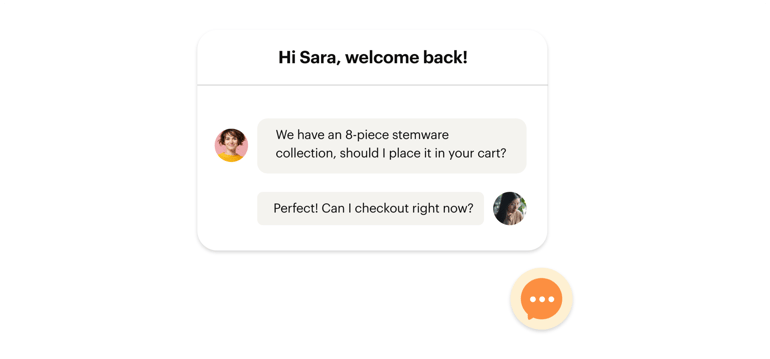
See why top ecommerce brands use Miva’s no-code platform to run
multiple stores, manage massive catalogs, and grow their revenue.
As businesses continue to address uncertainty in the overall economic environment, ecommerce sellers will greet 2023 with an emphasis on diversifying sales and marketing channels, while taking steps to significantly improve shopping experiences for customers. With costs rising for goods and customer acquisition, it will be imperative for online businesses to reach customers wherever they are, and provide a satisfying, loyalty-building buying journey which cements that relationship for the long haul.
These 15 ecommerce trends for 2023 represent key areas to develop for successful online selling. Read on to learn what systems, practices, and site features the ecommerce industry will be investing in next.
While supply chain disruptions continue to wreak havoc on fulfillment timelines, consumer expectations for shipping speed have accelerated in the opposite direction. Retail CEOs report that 2-3 day delivery is considered a baseline for 90% of shoppers, with 65% willing to pay for faster shipping. To meet these expectations and set the stage for long-term customer loyalty, a great ecommerce fulfillment strategy includes more flexible options for expedited delivery and real-time customer visibility for every step of the fulfillment journey.
Payment via digital wallet has soared in popularity in recent years, and is predicted to comprise more than half of all ecommerce transaction value by 2025. Sellers must master the art of mobile commerce by offering a comprehensive selection of convenient, secure mobile payment options...or risk missing the boat on how most consumers now prefer to pay.
Over the past three years, supply chain issues have caused online merchants to grapple with the challenge of unpredictable resource and product sourcing. Customers who find goods out of stock will quickly migrate to other options, so it’s crucial for businesses to have a clear understanding of their inventory needs long before surprise slowdowns occur. Predictive inventory management is the practice of using digital analytics tools to anticipate specific resource and inventory needs in advance. Powered by ecommerce integrations which link real-time inventory/order data across storefront, warehouse, and manufacturer, accurate inventory prediction will be increasingly critical for coordinating product availability and communicating it to customers.
Flexible ecommerce payment providers like Klarna, Afterpay, or PayPal’s Buy Now Pay Later (BNPL) allow customers to make interest-free installment payments on purchases. These services exploded in popularity in 2022, with more than half of sellers reporting increased conversions and brand loyalty via offering BNPL. Watch for 2023 sellers doubling down on flexible payments as a tool for reducing cart abandonment and boosting AOV. Consumers also love flexible payments, with 38% of shoppers reporting that BNPL services will eventually replace their conventional credit cards.

Reducing costs via automation and efficiency tools is not just a crucial way for businesses to remain competitive—sustainable business operations are now an increasingly important attribute for attracting customers. Not only do consumers care about Earth-friendly concepts like less wasteful packaging, holistic product sourcing, and lower carbon footprints, many will actually be willing to pay more and wait longer for sustainable purchases. Sellers who best communicate their commitment to sustainability can capture this business while simultaneously contributing to a healthy and thriving planet.

Pandemic-era online buying habits revealed accelerated acceptance of a diverse array of hybrid physical and online sales channels, with a whopping 73% of shoppers preferring to shop via multiple online channels. Retail customers have embraced channel-surfing their shopping experiences with buy online pick-up in store (BOPIS), store/inventory finders, virtual shopping assistants, and multi-device handoffs within the research and ordering process. Meanwhile, typical B2B buyers now use as many as 10 channels during a single buying journey. In all cases, sellers need to offer a seamless experience across devices, platforms, and showrooms, supported by dynamic site content that sustains branding across channels and leads consumers to the completed transaction.
Most sellers’ post-purchase customer service is centered on returns systems, and while seamless returns are important for every online business, savvy sellers are fighting high customer acquisition costs (CAC) by developing year-round initiatives for indefinitely engaging their existing customers. A social media feed isn’t enough—more proactive programs to keep customers engaged might include detailed support for individual products, loyalty-generating rewards, and encouraging customers to become brand advocates in the public square. However in order to keep customers long-term, sellers first need to learn what drives customer behavior today.

With online B2B sales reaching 1.77 trillion in 2022, the B2B ecommerce segment is more than double the size of digital B2C, yet outdated wholesale shopping experiences still lag way behind retail’s dynamic online presentations. As increasingly millennial B2B buyers now expect all the bells and whistles of high-end retail shopping, each B2B business stands to increase conversions by creating custom buying experiences which cater to the exact needs of their particular buyers. This might include product visualizers, bespoke order forms, virtual assistants, and real-time/negotiated rates and inventory built into the purchasing journey. Thoughtful and creative CX will not be limited to retail shoppers in 2023—sellers need to bring their most creative and dynamic presentation to every sale.
Selling direct to consumers (“DTC” or “D2C”) has become a huge trend for manufacturer-brands for years, with nearly 120 billion in US DTC sales in 2022 overall and more than 38 billion dollars in annual sales for digitally native US DTC sellers. A great DTC sales model is an important tool for managing rising inflation, giving sellers more control over how products are marketed, priced, and sold. These are important competitive advantages which allow businesses to weather uncertain and fluctuating conditions. For this reason, expect to see more ecommerce businesses selling B2B and DTC from the same website over the coming year.
Using customer data and preferences as a basis for personalized shopping experiences should be a given for every ecommerce business. Still, many companies don’t personalize content based on real-time customer data, even though large majorities of the public prefer personalized ecommerce. Why? Shoppers with many options want to feel like their unique needs are being addressed. Custom search, smart product recommendations, and relevant marketing content for different audiences/behaviors are all important ways of tailoring core site functionality to individual users.
The ”just-in-time” strategy for managing resources, inventory, and even web content can reduce overhead by delaying expenses until they are absolutely needed for current orders. However, continued supply chain disruptions through 2022 have made just-in-time riskier for sellers trying to match unpredictable customer demand. This doesn’t just apply to manufacturing...stores that wait until the last second to create website and marketing content for their businesses can also create expensive bottlenecks during sudden crunch times. To dial in an excellent cost-reduction strategy and meet customer expectations year-round, sellers need to see up-to-the-minute data for orders, traffic, user behavior, and site performance, then use that visibility to be ready “just-in-case" conditions change.
For ecommerce businesses, ensuring that the shopping experience is fully accessible to all shoppers will be a priority in 2023. In addition to meeting compliance goals, creating ecommerce shopping experiences which are accessible to a broad range of shoppers will help sellers grow audiences, improve customer satisfaction, and gain revenue. To create a great user experience and avoid potential lost sales, merchants should check and ensure that their website content is accessible to all.
B2B companies are planning huge marketing spends for 2023, with a strong emphasis on content marketing. Content was once thought of as the domain of retail, but marketing modern B2B ecommerce businesses now requires the same creative tools for attracting traffic, building brand awareness, and cultivating a customer community. Watch for more B2B sites deploying fresh marketing content like creative on-site imagery/text, social marketing, blogs, display ads, and podcasts, as well as acquiring new audiences by sponsoring influencers and paid newsletters.
Customer acquisition costs for ecommerce businesses have risen by 222% over the past 8 years, thanks in part to the loss of third party cookies, which previously had helped advertisers target ads effectively. As customer acquisition cost (CAC) on major ad platforms like Facebook, TikTok, and Google increases, ecommerce brands will off-set these costs by boosting investment in retaining existing customers and growing lifetime value through repeat purchases. For this reason, 2023 will see a greater emphasis on loyalty programs like year-round rewards, special product access, and post-purchase product support—all excellent ways to collect data and build lasting customer relationships.
Selling via chat is nothing new—ask any salesperson. For ecommerce brands, selling products “conversationally”—via a messaging app, a bot, or a voice assistant—is becoming big business. U.S. companies are preparing to invest more than 26 billion dollars in conversational commerce over the next decade, with good reason—live chat ecommerce sales humanize a business, and can increase conversions by more than 80%. Effective conversational commerce relies on asking relevant questions and then communicating the right recommendations and policies in real time.

The key to attracting and retaining ecommerce customers in 2023 is a diversified approach which integrates technology-enabled automation with data-driven insights about where and how to invest resources. Due to a highly competitive market and rising acquisition costs, businesses must now find customers across channels, and provide a seamless, highly-engaging shopping experience which keeps shoppers coming back for more.
How do you prepare your business to thrive in 2023? Use this 3-minute evaluation to discover new ways to analyze and refine your online business. Find out how your site performs for traffic, conversions, site management, and overall user experience…then get ready for a profitable new year.

Share this article:
No worries, download the PDF version now and enjoy your reading later...
Download PDF Miva
Miva
Miva offers a flexible and adaptable ecommerce platform that evolves with businesses and allows them to drive sales, maximize average order value, cut overhead costs, and increase revenue. Miva has been helping businesses realize their ecommerce potential for over 20 years and empowering retail, wholesale, and direct-to-consumer sellers across all industries to transform their business through ecommerce.
Visit Website